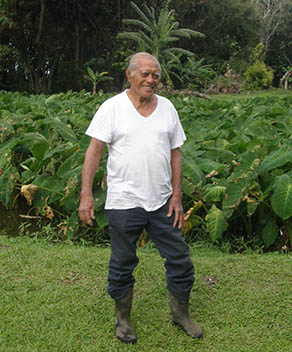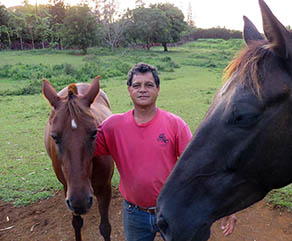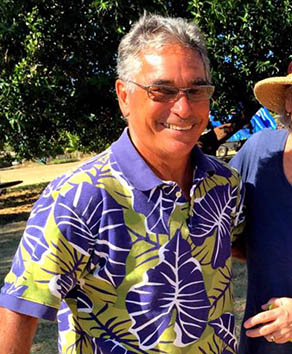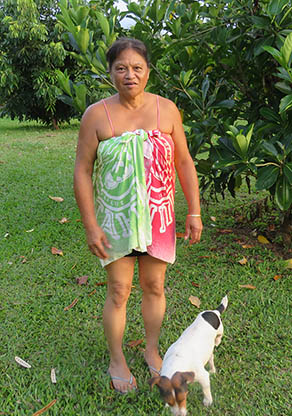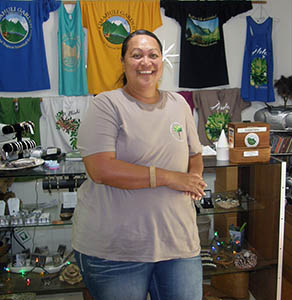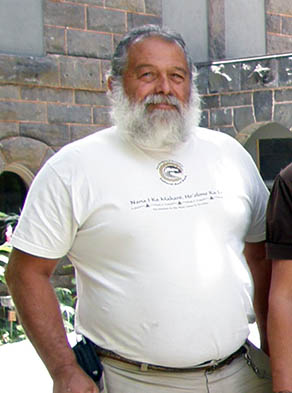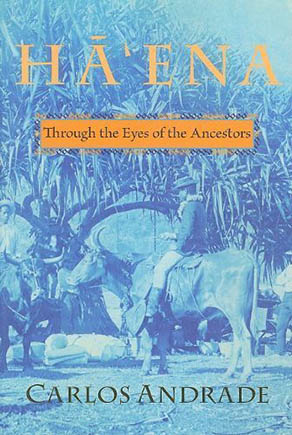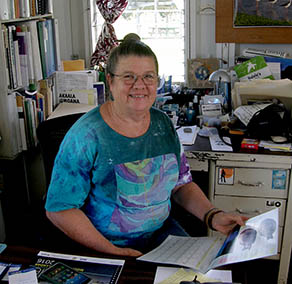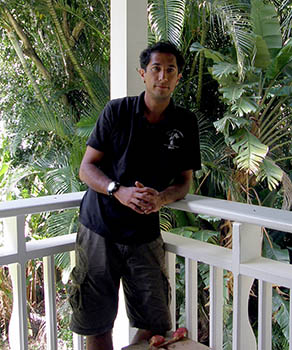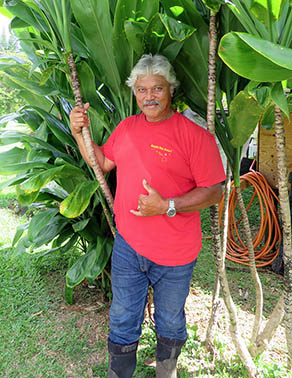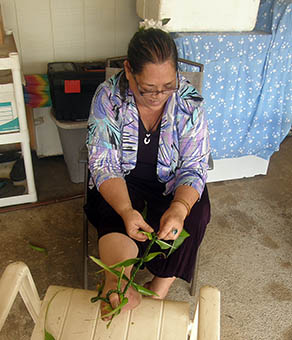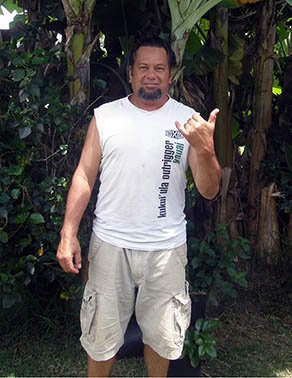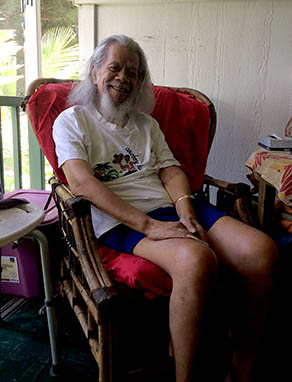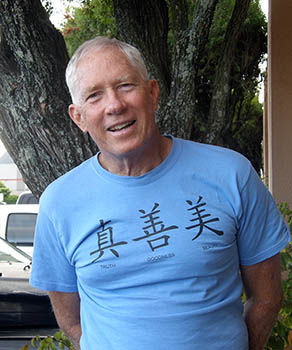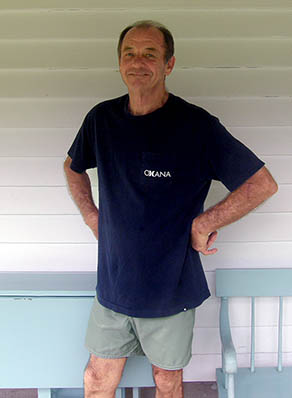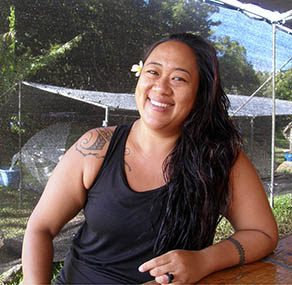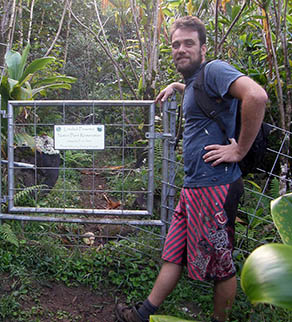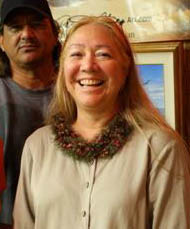 |
 |
 |
 |
||||||
|
|
|
|
|
|
|
|
|
|
 |
 |
||
 |
Our Guides to Hā‘ena and Kaua‘i | |
 |
 |
Aloha! We are grateful to the many Hā’ena and Kaua‘i folks who have contributed their mana‘o to this project. We are especially grateful to the Hui Maka‘āinana o Makana, Limahuli Gardens, and the Hanalei Watershed Hui.
|
 |
|
 |
Uncle Tom Hashimoto: “I’m Japanese-Hawaiian. My grandfather came home from Fukuoka to the Kona onf the Big Island to plant coffee. And then my Dad came from there. His uncle brought him over here from Big Island when he was 8 years old, and then he worked on the ship as a salamoku [deck hand] on those freighters that took all the cattle and the rice, the products from Waimea. “My journey began when I was twelve. My life, I picked up different games, and then now moreso. We had our own home charge and stuff, like making a garden, raising the chickens and stuff like that. And at the same time, doing stuff with our parents, like gathering hala and learning the way to do it. I hung around with the grand folks. But they would chase us away, because at the time Hawaiian was illegal, the Japanese language was illegal, and the language was English. So that’s why we didn’t learn, because my Dad was a terrific Hawaiian speaker, he could speak maybe better than the people today. “I’m a fisherman, I’m a ma‘i‘ai man [farmer] because I plant taro, and I started a long time ago. At four years old I used to work right up here, and I started my own farm in 1957. By 1959 I planted the place. And I know none of these people could do what I did.”
|
 |
|
 |
Samson Mahuiki:
“My Dad was pure Hawaiian. My mom looked Hawaiian! She was an orphan, her parents were old when she was born. We lived with one hanai child. Maybe nothing as sense as we think, you want one child you build a man. See if you’re busy and you need hands, that’s the best place for get them. Get one kid and then make him slave for you. “I’m not that full of anything about myself. I start up on (??) and everything and I just kind of let it lay outside, you know, I try not to bring attention to myself. I don’t want to be visible, I don’t want to be in the public. What I just want to be, anybody need help, for me, that’s where I go.”
|
 |
|
 |
Kelii Alapai: “I’m from Hā‘ena. Unfortunately I wasn’t born in Hā‘ena but raised in Hā‘ena all my life. It’s just one of those things. I was born in ’58, so when came back here, I was not even a year old. My grandmother took care of me and Hā‘ena was always my home. But my parents are from there. I am 57 years old, I have a beautiful wife, I have two kids, a girl—a daughter and a son, and I have a little granddaughter. She is 8 years old. "And Hā‘ena is a very special place for me. Everything that surrounds Hā‘ena—just being in Hā‘ena—the life style that we grew up there in Hā‘ena—it’s so fortunate. I mean, really we’re just so lucky to have that passed on to us. And for me, that’s my life, that’s how I live." “I guess I am living the Hā‘ena style, what we were taught, how we were raised. And that goes from mauka to makai. It wasn’t an easy life back then. Free time—no such thing as free time in those days. Everything was 'do something that is going to be worthwhile—work.' My Dad was pretty strict. And I understand that. "Today maybe that’s why I am the way I am—what I can do, from horses to raising animals. Because we did that: we raised all our own food, from pigs to chickens, to cattle, to you name it. We did it all. I have no regrets on how I was raised and learned our culture. Hā‘ena has so much mana in that place. We go there, we don’t want to come home. It’s a special place. For me there is no other place in the State of Hawai‘i that I can call my home. Hā‘ena is my home.”
|
 |
|
 |
Presley Wann:
“I’m the current president for the Hui Maka‘āinana o Makana of Hā‘ena Kaua‘i. I became involved with it because I have family ties to that area. We’ve been there for generations. Our kuleana lands extended from the road below Limahuli Gardens, all the way to the ocean. We had that whole bottom piece. We call it Kamealoha but it was Kaukapaua (?) is one of the names for that kuleana, but we are all heirs of Kamealoha. “There is a whole history behind Kaukapaua. And the history of the hui itself goes back to this group of 38 Hawaiians in 1875 that actually purchased Hā‘ena. They had a lot of foresight in that time and age when the concept of owning land was totally foreign. And so I am a descendant of one of the purchasers. Most of the people that are in the current Hui Maka‘āinana are descendants of the Hui Kū‘ai ‘Āina.”
|
 |
|
 |
Nalani Hashimoto:
“I was being raised in Hā‘ena until I was 16 years old. Then we moved from Hā‘ena to Princeville, and then moved from Princeville to Kilauea in 1983 when my parents purchased a home. My grandfather Joseph Hashimoto was gifted a property in Hā‘ena by his uncle, Mahi‘ula. Keoni passed that property down to Grandpa. And so we lived there with my grandparents up until we moved in 1975 out of Hā‘ena. "We still have that family property out there, across from Makua. And the grand uncle that brought my Grandpa over from Kona is buried on the property there.” |
 |
|
 |
Lahela Correa: "My name is Lahela—my English name actually is Rachel—and Chandler is my maiden name. And I’m named after my Grandma Rachel Mahuiki, who was an incredible fisherwoman here. I was born and raised in Wainiha, that’s the valley one over from Hā‘ena. And my parents were born and raised in Hā‘ena. "The Chandlers moved from Maui. He was a judge. There was John Silas Chandler, was a judge on the south shore, Kalaheo or something like that. In the Chandler family, there were 14 siblings of my parents, my father’s side. They were born and raised right in Hā‘ena where Makua is, that’s one of front beaches and my father guys have fifteen kids. So we’re fifteen siblings. I’m number thirteen in line—on the bottom. And there were ten boys and five girls. So there’s a whole bunch of us here on the North Shore, which is the Wainiha Chandler’s. "There’s also the Kalihiwai Chandlers, there’s ten boys there, no girls. And on the other side, I believe very close to us, maybe ten or twelve kids, one of my uncles. And there is the west-side Waimea family. There’s more other kids, but we’re the majority of the Chandlers that have like ten kids. “I currently work here at Limahuli. I’m the visitor program manager, and so honored to be here. My main part, they call me the “Auntie Aloha.” It’s key for me to teach that style and with the staff. It starts with our staff. Because if it does not come out of us, we cannot teach that, it’s the key of success, in especially the cultural area. That’s my number one task for here, and keeping everybody in sync.”
|
 |
|
 |
Carlos Andrade: “Although not born in Hā‘ena, I spent many days and weeks there during my childhood, youth, and young adulthood. My father helped move a beachfront house back onto its foundations after the tidal wave of 1946. It had been picked up off the ground, turned around 180 degrees, and floated intact a hundred yard or so inland, where it was set down in a tangle of debris and hau, an indigenous variety of hibiscus. The owner, in reciprocation for my father’s assistance, permitted our family to use the house for several weeks each year for many years. “When I was thirty, it was in Hā‘ena that I met the woman who would eventually become my wife. In Hā‘ena, we and our first child spent the initial year of his life in a gardener's cottage next to Limahuli stream. He got his initiatial introduction to swimming there almost before he could walk. Although we left Hā‘ena to take up residence on family land in the Ko‘olau district, continuing visits to Hā‘ena in Halele‘a, calling on friends, working with the people, and seeking the thrill of the challenging surf there increased, strengthened, and nourished relationships with this special place. Two siblings followed our firstborn, all of them learning to swim in the pond at Limahuli near the cottage we had occupied formerly. “Intervening years brought more contact with kūpuna of Hā‘ena working to restore abandoned lo‘i to their former use. It was during these times spent together that kūpuna shared memories of times past. Some have passed away in the intervening years and some remain, but their stories keep the memories of life in this special place alive.”
|
 |
|
 |
We also had important input from a book Carlos wrote about Hā‘ena:
Material is also drawn from a book Carlos wrote about Hā‘ena: “My book Hā‘ena: Through the Eyes of the Ancestors is based on my dissertation research. I chose Hā‘ena because it’s just a rich place for my kind of research interests: the ‘āina and all that it contains. I’m part of the community in a way, in that I live in this community, I work with these people, like Barlow Chu, who is Presley’s uncle. He knew my father and I knew him long before I wrote this book. “A lot of the material I used are my own recollections of these older people of Hā‘ena who are no longer with us. I talked to them and interacted with them in the normal course of everyday life, most of time, it wasn’t in the context of a formal interview. Because I knew them, they are a part of my life. They’re the people that I worked with, they’re the people I went fishing with, and with whom I worked the land. Many were those who knew my father well.”
|
 |
|
 |
Makaala Kaaumoana: “I was born Kāne‘ohe. I’m not from this island. I’m in Hanalei because I married a Hanalei boy and I did not ever intend to do this work, but I was given the name Makaala in the traditional way at the age of one, by my mother’s sisters. Much to my mother’s chagrin, because the name Makaala—'eye' and 'path'—means 'watchful, vigilant,' and it tends to be an assignment. That’s what those women meant for it to be, and my mother really didn’t want this life for me. She wanted me to be a good little housewife and mommy and stay home. "Her mother is the tree from which this apple falls. Her mother—my grandmother—was a suffragette and a college graduate in a time that that was a very rare thing. And she left the legacy in my DNA that by-passed my mother altogether. My mother was quite an accomplished water colorist in the 30’s and early 40’s in Hawai‘i, and held a prominent position in the Territorial Legislature as an executive secretary. But that’s as high as she aspired to go. My mother’s family goes back five generations in Hawai‘i, so I am part Hawaiian. “I went to school in California and ended up staying there and having a career as a teacher—a nurse and a teacher and retired as soon as I could to come home. I went home to Kāne‘ohe and didn’t recognize my place. The house was still there, but I didn’t recognize the neighborhood, didn’t know any of the faces, and didn’t know any of the places. And that was in the late 80’s. "I did what Hawaiians did in those old, old days: I got back on the airplane and came to Kaua‘i. Because Kaua‘i was the place where we came for refuge, for respite, for family gatherings. Almost every kama‘aina family had some roots here. I’m not sure how that happened, but it has always been a place that we would come to recreate or to escape, or to gather. So for me it was a safe place, even though I hadn’t been here in years. "I got off the plane and rented as car and drove to the end of the road, as far as you can drive: Hā‘ena. Saw a sign in a yard, saying ‘house for rent,’ squealed my tires into the driveway and said ‘I’m here and I don’t care how much it is—I’m here, and it’s safe.’ And it’s a place that I recognize as being still okay. In the late 80’s the community of Hā‘ena had not been as impacted as it is now with an influx of big money—billionaires with a “ B” and transient vacation rentals. At that point you knew who your neighbors were and if you said ‘Do you know your place?’ people said, ‘Yes’āthey understood what had and they understood its value.”
|
 |
|
 |
Charles "Chipper"
Wichman, Jr. Chipper comes from an old kama‘aina family in Hā‘ena. His ancestors have lived in Hā‘ena for five generations. in 1976 Chipper's grandmother Mrs. Juliet Rice Wichman gifted the lower portion of Limahuli Valley, the larger of two valleys comprising Hā‘ena, to be a National Tropical Botanical Garden. It is now known as "Limahuli Garden," and is directed by Chipper, who earned a Masters Degree in botany. In 2003 Chipper took on the role of President, Chief Executive Officer and Director of the entire National Tropical Botanical Garden network.
|
 |
|
 |
Kawika Winter: “I’m originally from O‘ahu, in the ahupua‘a of Wai‘alae, in the moku of Kona. I moved here to Hā‘ena in 2005, to be the Director of Limahuli Garden Preserve, and I held that position until 2018. Since the summer of 2018 I have been a Research Associate with the National Tropical Botanical Garden, and I maintain several connections to Hā‘ena. "As the head administrator of the work that happened in Limahuli I directed biocultural restoration of the mauka (inland) areas of this community, as well as the education and interpreative programs in the botanical garden. Our work is based on the ahupua‘a concept, so our work extends beyond the borders our property, which is this 1,000-acre valley. "Part of my job has been being involved in a lot of the community initiatives—heavily involved in the nearshore fishery management initiative (Hā‘ena Community-based Subsistence Fishing Area) that we have all been collectively working on for the past few decades. I have also been a lead collaborator in the Hā‘ena Ahupua‘a Alliance, which aims to work collaboratively towards the biocultural restoration of this place. In that role, I have helped to bring in and guide research that happens in the entire ahupua‘a—from the top to the bottom—that we need to inform our holistic, adaptive management of Hā‘ena. “And I’m a strong supporter of the Hui Maka‘āinana, and a collaborator with them via the Hā‘ena Ahupua‘a Alliance. I have three degrees in Botany: Bachelors, Master’s, and Doctorate from UH Mānoa, with a focus in biocultural conservation. “I also studied under John Ka‘imikaua, he was my kuma hula from when I joined the hālau in 1997. I was an active member of that Halau until I moved here in 2005, and he passed away in 2006. I was just a very low-ranking, humble student in my time with the hālau.”
|
 |
|
 |
Michael Olanolan: “I was raised in Hā‘ena. My mom and dad are both from Kaua‘i—from Kalalau. My grandfather is from Kaua‘i, all from Hā‘ena. I grew up hunting, fishing, planting. Olanolan is a Filipino name, Visayan. Olanolan means ‘rain’ in Filipino. My dad is half-Visayan, half-Spanish. That’s what Olanolan means: rain. They say ‘oh-LAHN-oh-lahn.” “I started hunting when I was young—seventh grade or sixth grade, just tagging along, learning, and then eventually the old guys give up and you carry on the tradition. Horseback, walking, every which way. I’ve hunted the whole island all the way around. Hunting was a necessity back in those times, not like nowadays. Everybody pretty much ate from the mountain and the ocean. We did a lot of hunting. My dad and my uncles fished a lot, but you actually only fish when you need to. Nobody really fished every day. You catch what you can eat, pretty much. That’s the way it went. “Back then, we went hunting probably every other week. It could be sometimes every week. If you go this week, you don’t catch, you go in next week again. It’s not always all the time you going catch. It’s like fishing. You can’t go out there and not catch nothing. That’s the way it went.”
|
 |
|
 |
Ka‘iulani Mahuka:
“Mahuka is my great-grandmothers’ name and it refers to the heiau that are located in certain strategic points of the islands, which when lit up and connected form a time travel clock. So I come from a long line of women warriors that actually originated in Hā‘ena. That’s my connection to that area. Most recently I threw down the gauntlet with a multi-billionaire developer who was busily developing the last piece of coast line in Hā‘ena that had all of our mummies in the ground. So I’m very, very connected to the Hā‘ena area, in fact the only time I actually feel really normal is when I’m there. “For about the last fifteen years I have realized my life’s mission of being a mouthpiece for our people. I seem to be a communicator, and I host a radio show called Songs of Sovereignty that airs Wednesday mornings 9:00 to 11:00 a.m. Hawaiian time on Kaua‘i Community radio KKCR.org, so you can join us any time.”
|
 |
|
 |
Leilani Kalilimoku Kaleiohi:
“I started learning native cultural practices through my father, who was of pure native Hawaiian descent. He had a job that took us globally, but no matter where we were around the world, he was my foundation for Hawaiiana. He was my first hula teacher, followed by my Aunty Hannah then later Kumu Joe K. Kahaulelio. "Papa tried to teach me ukulele, albeit I was too rambunctious to learn at the time.. As I got older, he and my mother encouraged us gals to find our own path, find what we felt comfortable with, and so I did. I established a career in San Francisco and all of that, and then decided to move to the islands while in my late 20’s. I’ve been blessed with many more native teachers along the way. “I was born on an Air Force base where my parents met, and that’s how we ended up traveling. My father’s family is the Kalilimoku family. His father’s side is from Big Island and Maui. His mother’s family is all Kaua‘i born and bred. Back then it seemed the Maui guys liked the Kaua‘i girls, and so Kaho‘ohanohano of Maui ventured to Kaua‘i to marry my great-great-grandmother from the Kalalau Valley. Many of our families come from that lineage,...anyone related to Kaho‘ohanohano who came from Maui to marry a beautiful gal from Kaua‘i. My great-grandfather Stephen Kila was Tutu’s first born. She was a master chanter in her own right. As comes with the turf, they learned all the many different elements involved in their craft, passing that information along to our family generations. So briefly, that’s my ‘ohana, and if you happen to see or hear the name Kalilimoku on your genealogy, then we’re definitely related."
|
 |
|
 |
Donovan Kanani Cabebe: “I am a lineal descendent of Hawaiians who can trace their ancestry to the very first canoes that landed on Kaua‘i from Tahiti, as well as to the indigenous population that was discovered here by those very first canoes that landed in Hawai‘i. In this day and age, I consider myself to be a cultural practitioner in several cultural arts including the lua, healing arts, spiritualty and philosophies connected to the Hawaiian culture and the indigenous cultures of Hawai‘i. My connection to Hā‘ena goes back probably about 40 years in this time, beginning with my father who migrated to Kaua‘i Island and specifically to Hā‘ena from O‘ahu. “But culturally we have connection to that space that place going back more than 1,000 years. I feel a very strong connection to that place, I’ve been drawn to this place and called Kaua‘i my home for the last 15 years now, after having spent nearly 20 traveling around the world and the United States. I work in Ha‘ena currently at the Hanalei Colony Resort. I function as their cultural liaison and events and wedding department manager.”
|
 |
|
 |
Guy Kaleomalana‘i‘ikalani Holt:
“I reside here on Kaua‘i. I am 75% royal Hawaiian and I’ve also got the Kahuna Nui bloodline from my father’s side where I have Kamehameha blood line from my mother’s side. I was raised by grandparents, who taught me the culture, and they always told me I wasn’t Hawaiian, that I’m an ali‘i nui, and just always to remember that. To this day I’ve always believed that I’m part of the Royal Family, and we’ve never disappeared we’re always still here. “My trade—how I help pay the bills—is I’m a mason, but I also do framework and construction, a lot of construction work just to survive. My particular Hawaiian culture area is lā‘au lapa‘au. I also like the fishing and anything to do with the ocean and the reefs, and the seaweeds and the ‘opihi. Almost like the beginning of the Kumulipo, how it is introduced. It’s how the beginning of the creation was. And I like to feel myself like that. “My mother’s side is from Keaukaha, Hilo, and then my Dad’s side is from Waimea Valley, on Kaua‘i. So from the east of the east to the west of the west. I’m the person that helps to bridge our families together. And there are so many distractions it’s hard to keep everybody focused on our old culture and traditions, but I was lucky to be raised by my grandparents and they instilled that in me so I get to try and pass it on with all the other kids.”
|
 |
|
 |
Uncle Nathan Kalama:
“I originated from O‘ahu but we moved here when I was seven years old. We were not allowed to be part of anything Hawaiian except in hale pule [church] because my father was a Pentecostal minister, so Hawaiian culture—which included hula music and everything else—was not allowed in our home. It wasn’t until I went to Kamehameha Schools that I met a woman named Nona Beamer. And she started me on my journey to learn who, what, and why I am who I am. She became my first kumu hula. She allowed me in her classroom to be and feel Hawaiian at Kamehameha Schools when it wasn’t a practice to. I had a difficult time meeting both cultures, the Western culture and the Hawaiian culture. "I was actually trained to become a minister since I was three years old. I got to the point in my life where I chose entertainment, so I got disowned for a while but continued in the process of learning about who I was. Because I was a hula dancer, that was my avenue to learn more about my culture and music. I love music, both Hawaiian music and dance. “I came to a point in my life where I decided to start teaching. I didn’t ‘uniki under Aunty Nona. She did not want to ‘uniki me because she did not want to be the cause of any conflict between my father. I didn’t understand it at that time, but when I called her to ask if it was okay if I went to teach hula even though I didn’t ‘uniki. She wouldn’t teach me the old ways. I had a classmate. He and I took hula from her together, but he got everything, all the kahiko stuff from there. Me, it was just ‘auana. But I called her up and she said, ‘Yes, I give you my blessings.’ And she said, ‘Perhaps, you’ll understand now that you’re a person that’s out of the box. I couldn’t teach you things because it would keep you in that box of tradition.’”
|
 |
|
 |
Nalani Kaneakua ("Kaneakua"):
“I’m from the ahupua‘a of Anahola, moku o Ko‘olau. I'm a Hawaiian purveyor of premium sandwiches and salads retailed island-wide. "Growing up, my ‘ohana frequented Hā‘ena on the weekends, visiting friends and family. Fresh fish and music was always on the menu. Fiery woks and 'catch of the day' creatively prepared sparked an early interest in island favorites. "I do not think of myself as a cultural practitioner, but as a foodie passionate over ancestral foods and foods of culture. A journey that guides me through a rewarding career, infusing the past with modern-day flares, creating and inspiring a healther lifestyle of Hawaiian indulgence."
|
 |
|
 |
Andy Bushnell:
“I am from Honolulu on O‘ahu. I have lived on Kaua‘i since 1970 where I taught history at Kaua‘i Community College for 36 years, including Hawaiian History and Kaua‘i History. When I was in high school, back in the 1960s I spent parts of several summers on Kaua‘i, and like many visitors to Hā‘ena, I helped to plunder its reefs, spearing many lobsters and more fish than I needed. It was only later that I learned about the need to mālama (care for) the ‘āina (land). "As a professor I led many field trips to Wailua and ā‘ena and other special places on Kaua‘i, including Ke Ahu a Laka, the famous hula platform where dancers from all of the islands come to ‘graduate.’ One of my daughters, Kanani o Makana, is named in honor of the mountain that towers over this site. "However, I have not been to beautiful Kē‘ē beach in Hā‘ena in more than a decade because of the crowds of tourists that have have desecrated the area. One hopes that someday more of us will learn to mālama the ‘āina.”
|
 |
|
 |
Roger Kennedy:
“With my wife Barbara, I’m the caretaker, docent for the Wai‘oli Mission House Museum in Hanalei, Kaua‘i, Hawai‘i. I’ve been living in Hanalei for the last 45 years. I got this job in 1998, which I started studying about the missionaries coming to Kaua‘i and teaching the Polynesians, the Hawaiians, how to read and write their own language. "I learned about this place by reading the books, associating myself with the valleys and the beaches and the roads and things I was familiar with, living on the island, and then incorporating that into the knowledge that I learned from the books.”
|
 |
|
 |
Malia Kahaleinia Chun:
“I am from the ahupua‘a of Wailua nui a hoano, ka moku o Puna. I run a cultural enrichment program called Nā Pua No‘eau at the University of Hawai‘i and probably the biggest part of my job is community outreach in rural Hawaiian communities. What I do is I create a bridge for Hawaiians, young Hawaiians, kamali‘i childen, ‘ōpi‘o, youth that are looking to pursue an education beyond high school. And I try to create that bridge for them in discovering their passion. “Hopefully in discovering that passion, they develop a better understanding of who they are as kānaka, and hopefully in their understanding they are able to pursue a career-educational pathway that they are passionate about. And in doing so, I’ve been blessed to work with the community of Hā‘ena, in particular Hui Maka‘ā inana o Makana.”
|
 |
|
 |
Merlin Edmonds:
“I’m the botanical coordinator here at Limahuli. I’ve been working here since about 2008 or so. I work in the preserve. I’m the rare native plant specialist here and I run the restoration site as well as a lot of the invasive weed programs and a lot the rare plant collecting and monitoring. I was born on O‘ahu and grew up in Kilauea.”
|
 |
|
 |
We are pleased to have further input from two other persons:
|
 |
|
 |
Carol Silva, whose historical study of Hā‘ena has been enormously important to the our understanding of Hā‘ena
|

The late Frederick "Uncle Bruce" Wichman, whose shared his books on Kaua‘i legends and spoke with us about traditions of Kaua‘i and Hā‘ena. |
 |
 |
Through this people who have generously shared with all of us their insights and exerpeices, we gain first-person insights into life and legend in Hā‘ena, past and present. Their stories and knowledge are supplemented by historical records, maps, photographs, and contemporary writings, as well as insights on Hawaiian life and culture from the writings of Mary Kawena Pukui and Samuel Manaiakalani Kamakau. Pacific Worlds welcomes you to explore this beautiful place through a series of ten thematic topics. Within each of these, you will find short, focused sections exploring particular aspects within that theme. Provided also are bibliographies and links to external sites that will teach you more about the topics discussed.
|
 |
||
 |
|
 |
||

|
|
||||
| Copyright 2018 Pacific Worlds & Associates • Usage Policy • Webmaster |
||||
